The heart and soul of the Colorado Plateau in southern Utah is expressed through canyons, arches, spires, and mesas carved by the Green and Colorado Rivers.
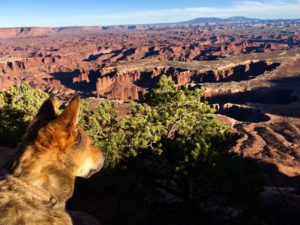 It’s almost impossible to wrap my mind around so much stunning beauty but it is as natural as breathing to allow all of that to become all of me. In my prayers and practices it also flows to each of you.
It’s almost impossible to wrap my mind around so much stunning beauty but it is as natural as breathing to allow all of that to become all of me. In my prayers and practices it also flows to each of you.
If you’d like to experience it yourself two national parks help millions access some of the area annually – Arches and Canyonlands. Fortunately most stay on the paved, scenic routes highlighting the parks.
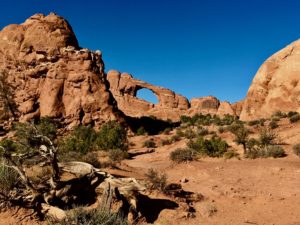 Inside both parks there is no food, gas, or other amenities. Each has one national parks campground.
Inside both parks there is no food, gas, or other amenities. Each has one national parks campground.
Most of the roads in this region are unpaved, camps are primitive, and rivers are free-flowing. Native plants 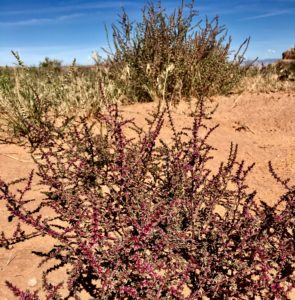 and animals still live in much of this remote, rugged, and wild countryside. Lots of folks call it “The American Wild West” but it’s been around much longer than we have and God willing will continue long after we’re gone.
and animals still live in much of this remote, rugged, and wild countryside. Lots of folks call it “The American Wild West” but it’s been around much longer than we have and God willing will continue long after we’re gone.
Trying to balance recreational use with protection of these amazing resources requires effort by all of the major stakeholders – the Bureau of Land Management (BLM, often called public land), the National Park Service, charitable associations, and YOU.
Please do your part to protect this ancient, wild land. Follow “Leave No Trace” rules especially in designated and dispersed camping, hiking, biking, and OHV adventures.
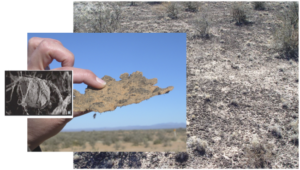
Here’s the deal. The biological soil crust is extremely fragile in the desert. The cyanobacteria and other materials in the soil are some of the oldest life forms, trapping and storing water, nutrients, and organic matter not otherwise available. It’s suited for harsh, arid conditions but vulnerable to compression.
 A thin, fragile veneer of biological soil crushed by your footprints alone (compression) may require five to seven years to recover. Cyanobacterial growth can take 50 years and lichens/mosses even longer.
A thin, fragile veneer of biological soil crushed by your footprints alone (compression) may require five to seven years to recover. Cyanobacterial growth can take 50 years and lichens/mosses even longer.
If you’re going off-road to visit the area, be ready to rough it and take care of your own needs. Pack in what you need. Pack out everything – including human waste where restrooms are not provided. Remember that five to seven year recovery time just for a footprint? Enough said.
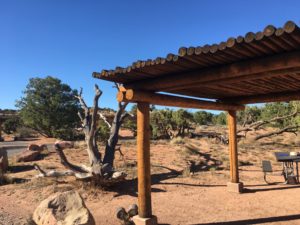
Each national park has one developed campground with vault toilets, tables, and fire rings. Maximum length for RVs is 28 feet. There are no hook ups or dump stations in either park. Most are first come, first served except group campsites and a few individual sites. To reserve online go to http://www.recreation.gov or call 877-444-6777 (toll free) and +1 518-885-3639 (international).
Backcountry or Primitive Camps in the national parks require permits. These can be reserved four months in advance. Day use for 4×4 vehicles, motorcycles, and bikes can be reserved up to 24 hours in advance. Permits can be obtained online at http://www.go.nps.gov/canybackcountry
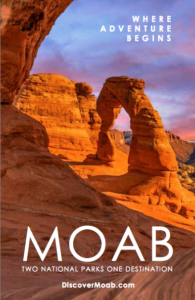 The BLM maintains 26 designated campgrounds with vault toilets, tables and fire rings. Drinking water is available at Lions Park (Hwy 191 and SR 128). The Windwhistle and Hatch Point campgrounds have drinking water on site from mid-April to end of September.
The BLM maintains 26 designated campgrounds with vault toilets, tables and fire rings. Drinking water is available at Lions Park (Hwy 191 and SR 128). The Windwhistle and Hatch Point campgrounds have drinking water on site from mid-April to end of September.
BLM On-line information about camping in Moab area.
BLM Moab Field Office, 82 E Dogwood Moab, UT. Phone is 435-259-2100.
Here’s some of my favorites and soon to be favorites. For a complete list of camping options check out the Discover Moab site.
BLM Camping Outside the National Parks
 The Moab BLM Field Office manages over two million visitors annually on 1.8 million acres in the heart of the Colorado Plateau.
The Moab BLM Field Office manages over two million visitors annually on 1.8 million acres in the heart of the Colorado Plateau.
![]() Reservations are not accepted except group camps. All are first come first served. All BLM developed campgrounds have vault toilets, picnic tables, and metal fire grills. Fees are $10-$20/night.
Reservations are not accepted except group camps. All are first come first served. All BLM developed campgrounds have vault toilets, picnic tables, and metal fire grills. Fees are $10-$20/night.
 Weather can make unpaved roads impassable. Check with rangers for latest conditions.
Weather can make unpaved roads impassable. Check with rangers for latest conditions.
The Visitor Centers at Arches and Canyonlands have detailed maps for 4×4 routes, hiking and camping. Topo maps are also available.
Developed Campsites
SR 313 Camps Between Arches and Canyonlands Island In the Sky National Parks
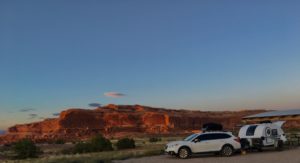 Lone Mesa Group Camp
Lone Mesa Group Camp
- (5 spaces)
- Gravel road and camp
Cowboy Camp at junction of Scenic Byway and Island in Sky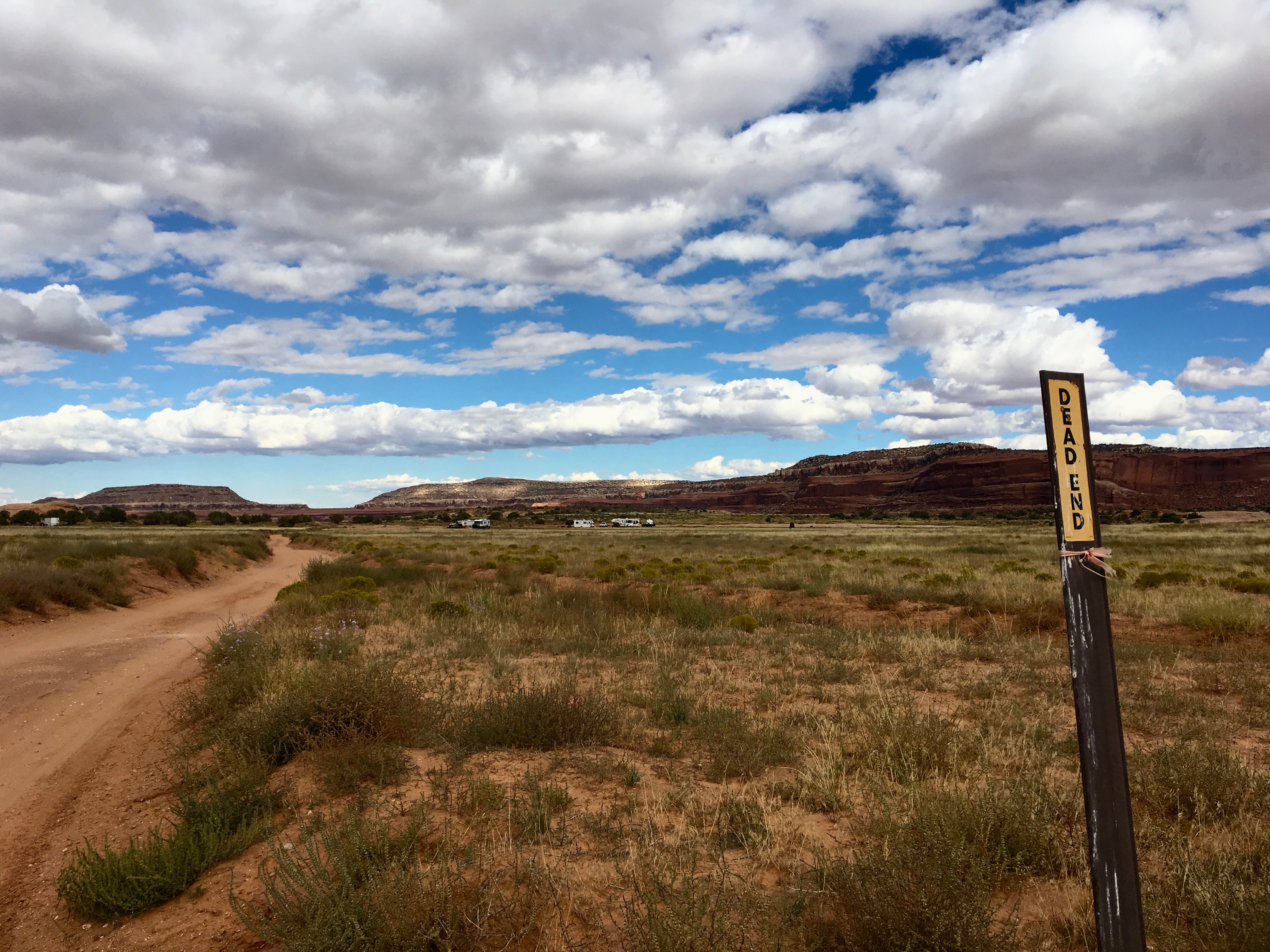
- (7 spaces)
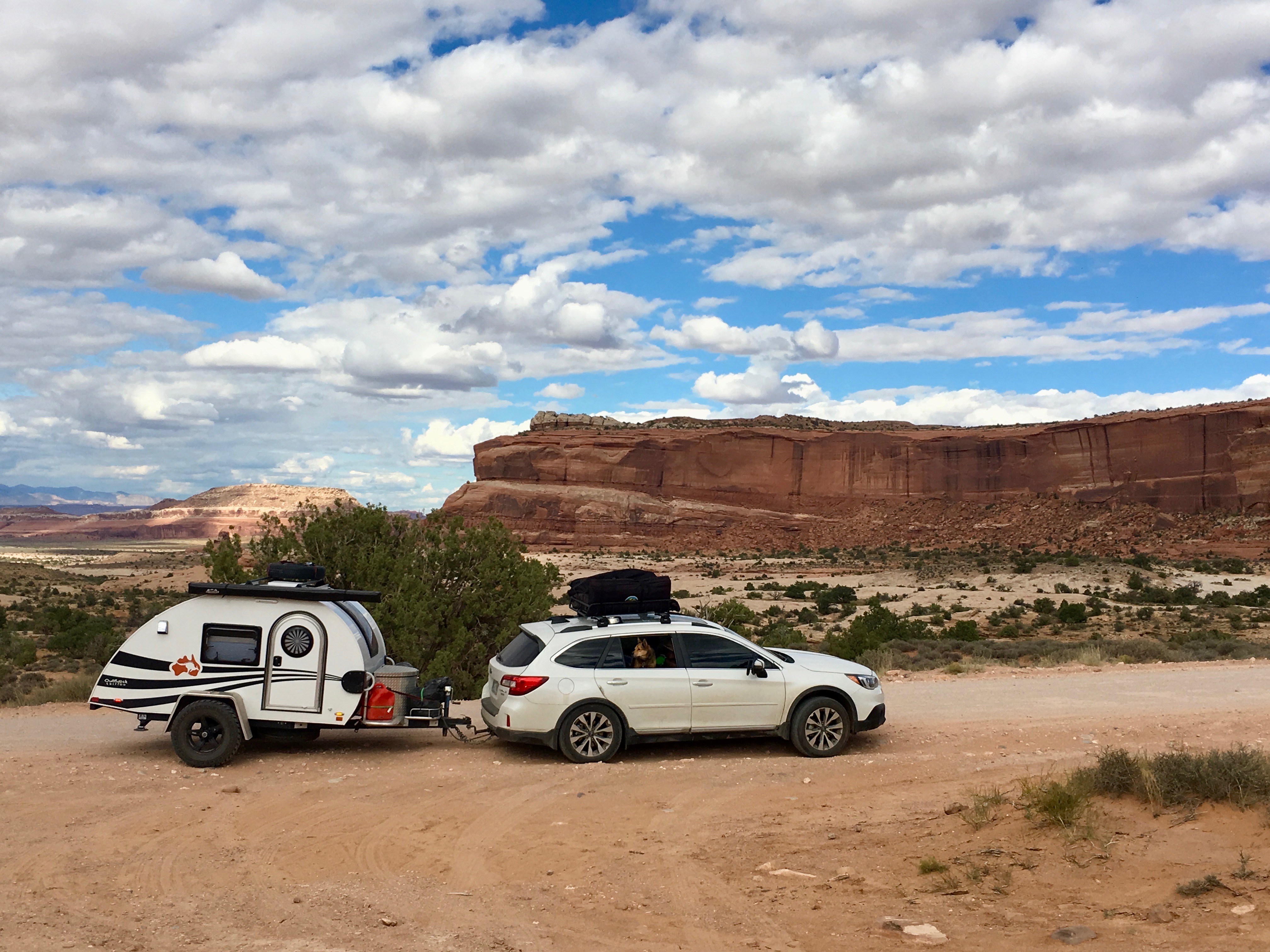
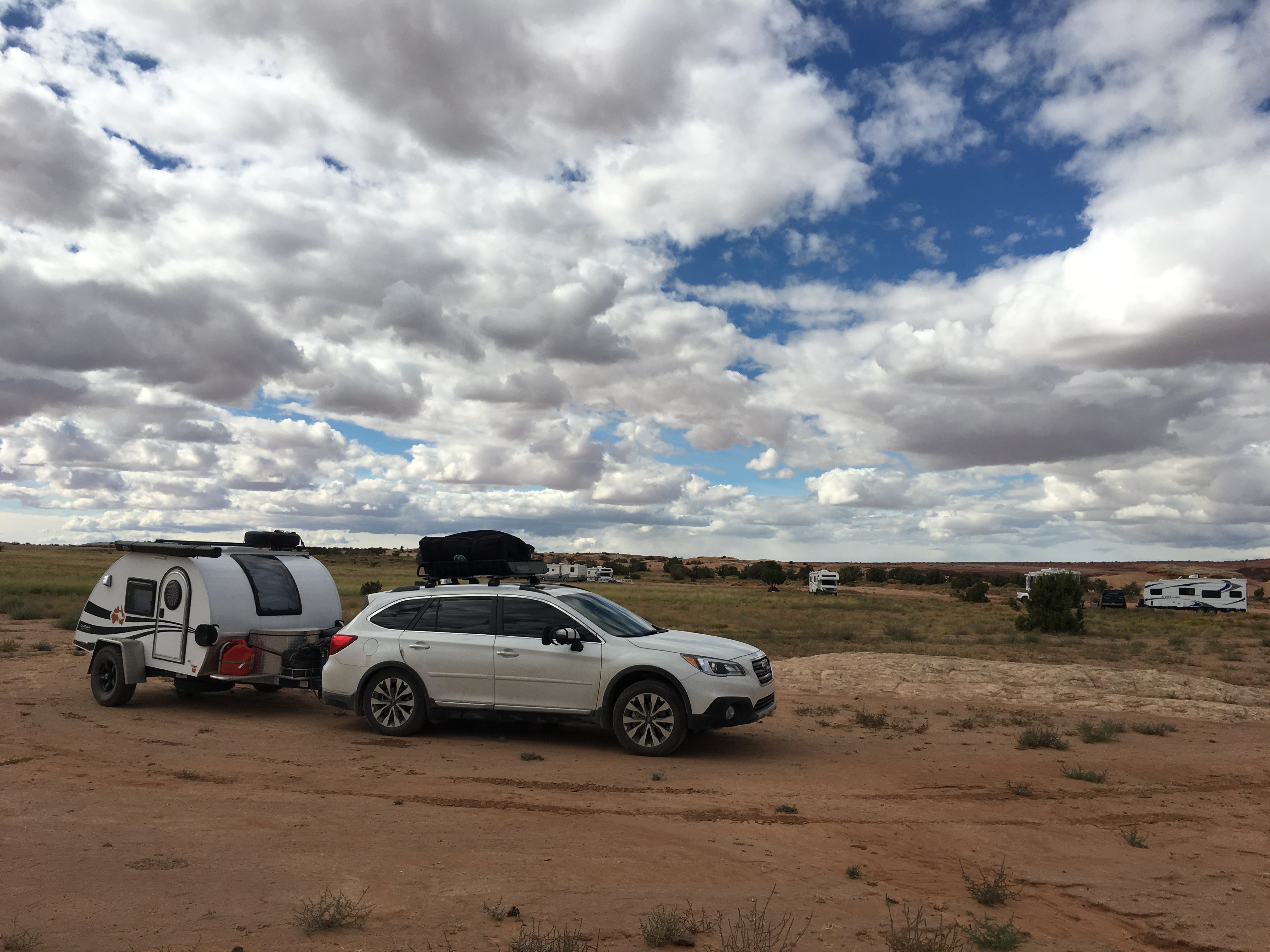
- Dirt road and camp

 Horsethief off Mineral Point Road by Deadhorse Mesa.
Horsethief off Mineral Point Road by Deadhorse Mesa.
- (56 spaces)
- Dirt road and sandy, flat area for camp. This is where larger RV’s park.
HW 128 Camps Closest to Arches
The further you go the prettier and less congested the sites. Fisher Towers and Onion Creek sites are my favorites.
- Granstaff 3 miles ( 16 spaces)
- Drinks Canyon 6.2 miles (17 spaces)
- Hal Canyon 6.6 miles (11 spaces)
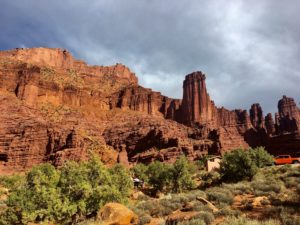
Fisher Towers Campground - Oak Grove 6.9 miles (7 spaces)
- Upper Big Bend 8.1 miles (8 spaces)
- Upper Onion Creek 21 miles then .7 miles SE on gravel road (2 spaces)
- Fisher Towers 21.5 – dirt road (5 sites)
- Lower Onion Creek – 21.5 miles then 1 mile NW on gravel road (4 spaces)
HW 257 South of Arches
- Jaycee Park – 4.2 miles (7 spaces)
- Williams Bottom – 6 miles (17 spaces)
- Goldbar – 10.2 (5 spaces)
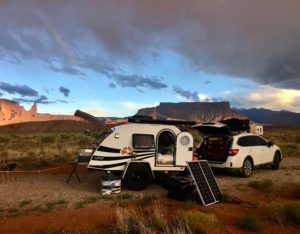
BLM Dispersed Camping – No Services/Facilities
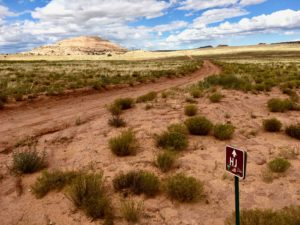
The BLM offers over 30 single or small, primitive camp sites with no services. These are first come-first served and free. Sites are marked with a brown post and a tent symbol.
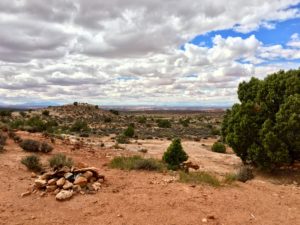
This is serious “Leave No Trace” camping. You must use portable toilets. All trash must be packed out – including human waste. No wood cutting, creating new camping areas or fire rings. Do not drive, hike, ride off road. Please.

![]() There are 25 sites in the Mill Canyon-Cotter Road/Dubinky Road Area.
There are 25 sites in the Mill Canyon-Cotter Road/Dubinky Road Area.
 Primitive Camping – Island in the Sky Section of Canyonlands National Park
Primitive Camping – Island in the Sky Section of Canyonlands National Park
Accessible by 4×4 Taylor Canyon, White Rim, Potash, and Shafer Roads
4 primitive camps along Green River
Labyrinth – Where Taylor Canyon Road meets White Rim Road on the Green River in Upheaval Canyon
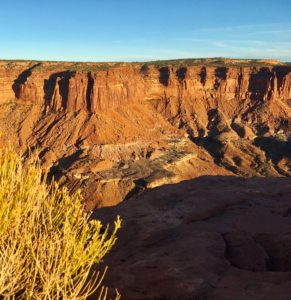 Hardscrabble – South of Hardscrabble Bottom
Hardscrabble – South of Hardscrabble Bottom
Potato Bottom – along the 14.8 mile Potato Bottom straight stretch of White Rim Road
Candlestick – Southern part of Holesman Spring Basin. South of Wilhite Trail on White Rim Road
4 primitive camps on southern loop of White Rim Road
 Murphy Hogback – near Murphy Point trails
Murphy Hogback – near Murphy Point trails
White Crack – in the Lower Basins at end of 1.4 mile road
Gooseberry – where trail meets road near Gooseberry Canyon
Airport – By Airport Tower in Lathrop Canyon
1 primitive camp near Visitors Center
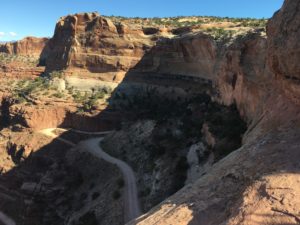
Shafer Near Visitors Center NE of where Potash Road meets Shafer Trail Road, Shafer Canyon. This gives access to the spectacular Goose Neck area of the Colorado River.
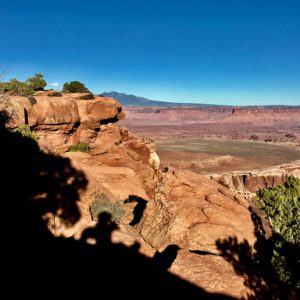
No matter where you may set up camp you’ll discover tons of ways to wear yourself slick having adventure fun. Remember to take some time to sit and stare for awhile. You’ll be glad you did.
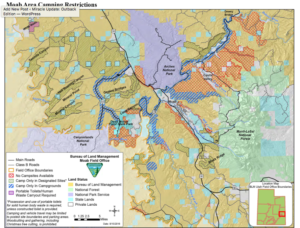
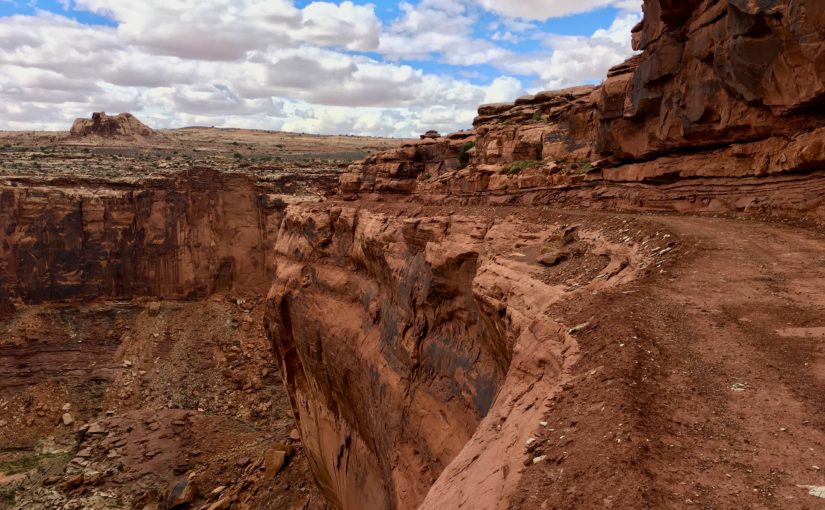
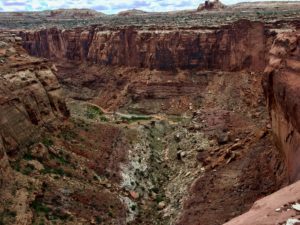 Narrow, ridiculously steep grade, no safety rails and the most amazing, adrenaline-inducing experience calling my name! The Subaru and teardrop had torn up off roads for days and I was primed for the grand prize dive down The Canyon.
Narrow, ridiculously steep grade, no safety rails and the most amazing, adrenaline-inducing experience calling my name! The Subaru and teardrop had torn up off roads for days and I was primed for the grand prize dive down The Canyon.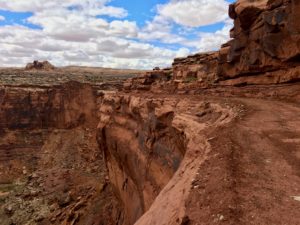 Perhaps a bit of recon was in order. Rapid, shallow breathing and heart-pounding adrenaline with knees bent, eyes straight ahead helped resist the abyss tractor beam pulling me over the edge on the switchback curves. Barely. There was just enough width for the car and RV. No margin for error, changing my mind or turning around. There might be a clearance and mud issue. But I was a hound dog on a scent. Ride The Canyon or bust!
Perhaps a bit of recon was in order. Rapid, shallow breathing and heart-pounding adrenaline with knees bent, eyes straight ahead helped resist the abyss tractor beam pulling me over the edge on the switchback curves. Barely. There was just enough width for the car and RV. No margin for error, changing my mind or turning around. There might be a clearance and mud issue. But I was a hound dog on a scent. Ride The Canyon or bust!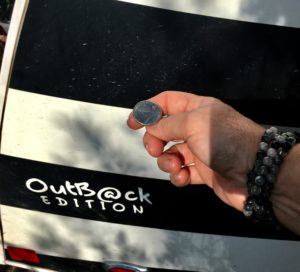 Time to pull out the big guns and use a technique honed over eight years in the halls of MD Anderson Cancer Center. Call in my angels when stakes are life OR death high. Employ the hallowed Coin Toss. Best two out of three wins. Heads means I go for it, tails I turn around and find a camp for the night.
Time to pull out the big guns and use a technique honed over eight years in the halls of MD Anderson Cancer Center. Call in my angels when stakes are life OR death high. Employ the hallowed Coin Toss. Best two out of three wins. Heads means I go for it, tails I turn around and find a camp for the night.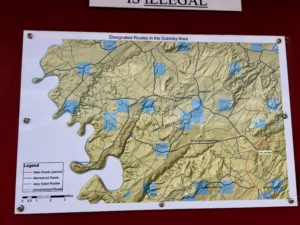 My best guess is I was in the Sheep Canyon area. GPS noted Mineral and Dead Horse Point Roads. I found an OHV trail map sign post indicating I was somewhere in the Dubinky area. Maybe The Canyon was a piece of Hell Roaring or Chicken Corners Trails. The coin toss occurred at the point requiring gate entry, is pinched between rocks on the right and the abyss on the left and drops over 1,000 feet via narrow, rocky, muddy switchbacks. Chicken Corners is where Moab area guides allow “chicken” passengers to walk, rather than ride. And Hell Roaring Canyon descriptions involve the word “pucker.”
My best guess is I was in the Sheep Canyon area. GPS noted Mineral and Dead Horse Point Roads. I found an OHV trail map sign post indicating I was somewhere in the Dubinky area. Maybe The Canyon was a piece of Hell Roaring or Chicken Corners Trails. The coin toss occurred at the point requiring gate entry, is pinched between rocks on the right and the abyss on the left and drops over 1,000 feet via narrow, rocky, muddy switchbacks. Chicken Corners is where Moab area guides allow “chicken” passengers to walk, rather than ride. And Hell Roaring Canyon descriptions involve the word “pucker.”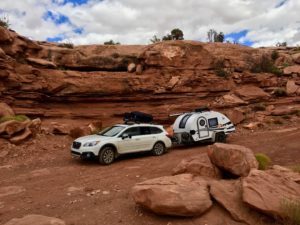 I probably have too much faith in Beverly (my Subaru Outback) but I think she’d make The Canyon. Pulling my Outback teardrop camper affectionally dubbed Hillbilly? Sheer lunacy.
I probably have too much faith in Beverly (my Subaru Outback) but I think she’d make The Canyon. Pulling my Outback teardrop camper affectionally dubbed Hillbilly? Sheer lunacy.